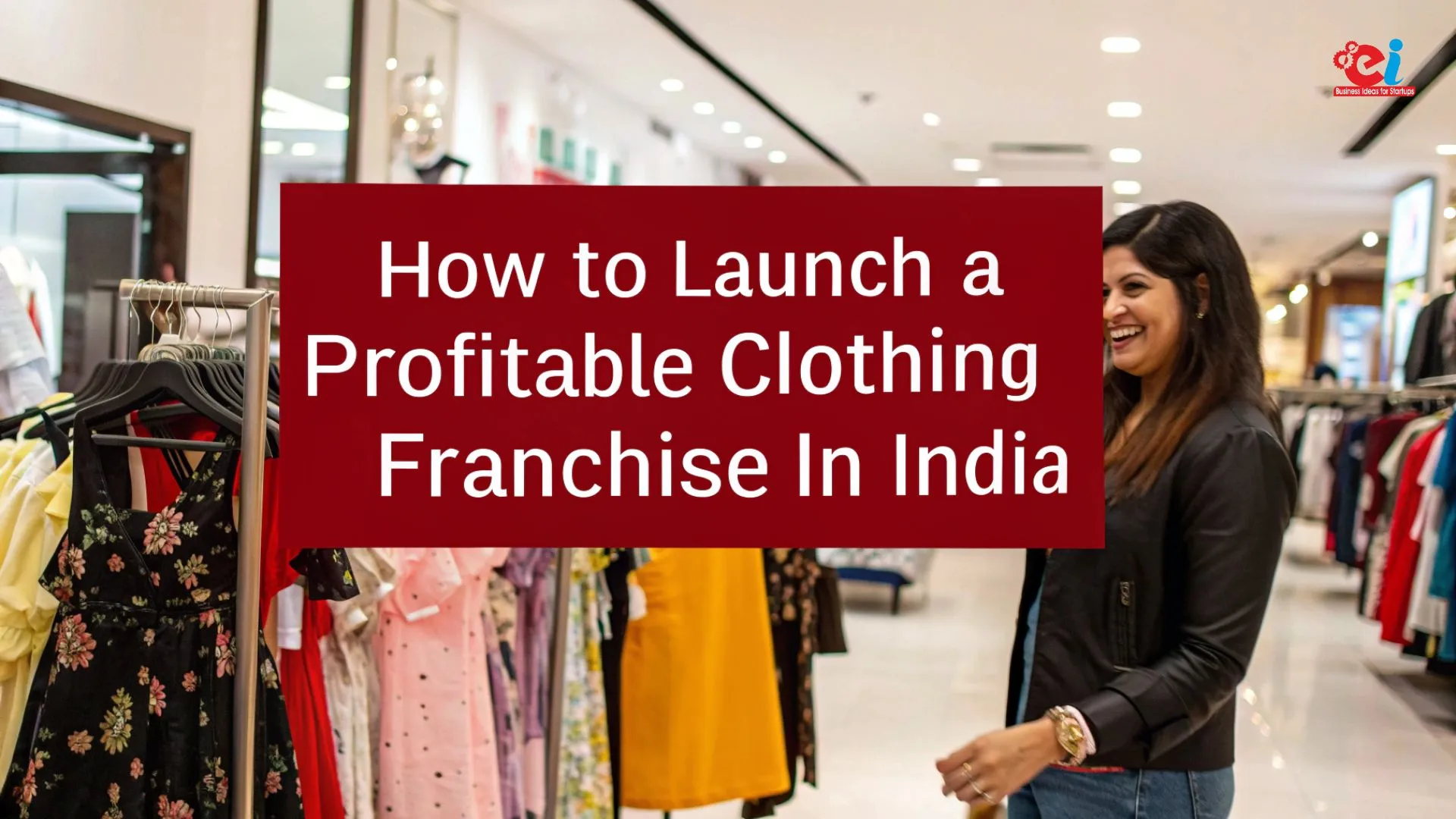Why Clothing Franchises Are a Smart Business Move
The Indian retail and apparel business is no longer restricted to big metros or luxury areas with high-end amenities. Over the last 10 years, an important shift has taken place: branded Clothing Franchise is now being delivered to the doorsteps in Tier 2 and Tier 3 as well as semi-urban India because of an aggressive model of franchising.
Inspired by aspirational consumer’s social media influence and growing earnings per capita, Indians today prefer organized and branded clothing over unorganized retail. At the same time, brands are moving beyond corporate-owned stores to more flexible, scalable business models, with franchises being among the most sought-after.
For young entrepreneurs, starting the clothing franchise is an ideal middle-ground. You don’t have to construct your brand from scratch yet you’ll have the freedom to run the business, run it, and earn a profit from a company with a proven demand.
But establishing the right clothing franchise not only about money and place. It requires a strategy as well as brand alignment and operational understanding. This guide guides you through each step from understanding the market to executing and will help you develop a highly successful retail venture.
The Market Potential: Why Apparel Retail Is on the Rise in India
India is the sixth largest market for apparel worldwide, and its direction is influenced by an urban-smart, young and brand-conscious populace. This market is expected to reach Rs7.5 lakh crore in 2025, with branded clothing making up a significant portion of that. While metros are still significant, the true growth story is being played out within Tier 2 as well as cities in Tier 2 and 3 cities where people are shifting away from local tailor-made or non-branded clothing to more well-known fashion brands.
This demand shift is opening up vast opportunities for clothing franchises–especially in segments like ethnic wear, fast fashion, kidswear, casualwear, innerwear, and affordable lifestyle fashion. As Indian customers continue to seek out the latest trends in retail Franchises are emerging as the most effective way for brands to expand and offer local entrepreneurs with a plug and play business model.
What makes this model more viable is that retailer penetration within India is at the low end of 40 percent. This means that the market untapped is huge and ready for entrepreneurs to fill the gap between brands in smaller cities.
Related: How to Launch a Profitable Small-Scale Garment Unit
Understanding Franchise Ownership in Fashion Retail
The franchise model, especially in the fashion industry, lets entrepreneurs run the store under a reputable brand name while maintaining their operating standards. Fashion franchises are typically operated with the FOFO (Franchise owned by a franchisee) model. In this type of model you are required to invest in the establishment of your store and make an amount for security, and manage the store on your own with the support of the brand you with merchandising, education as well as brand marketing, inventory management and display procedures.
A lot of brands also assist in scouting locations as well as store layout design and visual merchandising to ensure an identical branding experience across all geographies. In exchange, you receive a commission (in percent of revenue) or work under the model of stock-and-sell, in which you purchase the inventory and sell it at a mark-up price.
Choosing the Right Segment and Brand
Before you enter the franchise system before you can enter the franchise ecosystem, you need to determine which area you would like to be in. In the Indian fashion market can be very diverse and segmented, with every segment catering to a specific buyer’s mindset in terms of price, size, and growth rate.
For instance ethnic wear brands like Manyavar, Biba, and W are great for weddings and festive seasons. Additionally, mass brands with a focus on value such as Zudio (by Tata Trent), Max, and Reliance Trends excel in semi-urban and urban settings because of their cost-effective fashion collections. International brands such as Levi’s, United Colors of Benetton along with Van Heusen appeal to premium urban shoppers looking for western wear.
Your choice should be based on:
- Customer base of the target and city type
- The opportunity to invest
- Experience in fashion or retail
- Long-term vision (niche or mass-market)
In certain circumstances it’s logical to have multiple stores that are under the same brand or run multi-brand retail formats, based on the local level of saturation.
Finding the Right Location: The Heart of Retail Success
Retail is a location-based business. Success of any clothing business is dependent on being in the right spot, which is where the customers you want to attract naturally shop, browse and then return. Although many entrepreneurs seek out malls or huge complexes but it’s usually commercial areas on the street such as urban markets, and smaller plazas that result in higher traffic and more conversions.
If you’re looking to acquire the Zudio or Max-type franchise the semi-premium locations close to urban housing and educational hubs or transportation corridors can be a good choice. For high-end wedding or ethnic wear an exclusive showroom close to the most luxurious markets or wedding venues is the best option. Franchises for innerwear and kidswear typically work well in malls or areas with a high family and female patrons.
The most reputable franchise brands will examine the site you have selected before signing their franchise agreements. They might even help with leads for real estate according to the expansion plan they have.
Related: Investment Opportunities in the Production of Viscose Filament Yarn. Market Growth of Textiles and Clothing Industry.
Understanding the Investment Breakdown
While the investment in franchises varies by model, brand and even city The following is a rough outline of where your money generally will go:
- Secure Deposit for the name (Refundable or non-refundable)
- Costs for setting up a store (Interiors fixtures trial rooms, branding)
- Initial purchase of inventory or supply consignment
- Software and POS configuration
- Operating and licensing costs
- Launch promotions or marketing (often associated by the brands)
The cost of a clothing franchise vary from as little as the small children’s clothing range of Rs15 lakh brands up to Rs70 lakh to Rs1 crore for large-scale outlets of brands such as Zudio and Levi’s. Some brands run under consignment arrangements (where you don’t have to purchase stock) and others require a full purchase.
Your ROI is contingent on the location the marketing effort in your local area as well as the quality of your footfall and the efficiency of your operation.
Managing Day-to-Day Operations
When your store is operational the day-to-day operations focus on inventory management customers, customer service, monitoring of staff, billing and upkeep of displays. You follow the established operating guidelines set in the franchise’s brand. This includes guidelines for:
- Time of opening and closing for the store
- Standard grooming uniforms and uniforms
- Rewards programs or loyalty programs
- Promotions in-store and special events
- The replenishment of inventory and seasonal clearances
It is typical to have a group of sales associates that range from 4-6 and a store manager based on the size of the store. Brands regularly conduct workshops, audits, as well as store inspections to verify that compliance and efficiency.
The main responsibilities of an owner of a franchise include:
- Ensuring strong customer experience
- Management of employees and cutting down on turnover
- Achieving sales goals and maximising conversions
- Coordination with the backend of the brand on billing, inventory and reporting
Marketing and Growing Your Franchise Business
While national-level branding and advertising are managed by the franchise brand, local marketing is yours to manage. Furthermore, this includes engaging with your community, promoting offers specific to your city, collaborating with local influencers, and making your business accessible on digital platforms.
It is recommended that you regularly:
- Run geo-targeted Facebook/Instagram campaigns
- Organise small-scale events in-store (launches and discounts for college students)
- Collaborate with nearby cafes, salons, or gyms to promote co-promotions
- Create a store listing online on Google for regular reviews and updates.
Additionally, you should develop a local CRM strategy. You can collect numbers of customers, then send WhatsApp updates on special offers, festivals, collections for the season or loyalty benefits. The development of trust and confidence among the community keeps your store’s relevance, even if it goes beyond the brand’s identity.
Watch the related article for more information
Common Pitfalls and How to Avoid Them
While franchising provides structure but it’s not without its obstacles. The entrepreneurs who fail often underestimate the amount of work needed to operate retail shops efficiently.
Staff turnover and seasonal sales declines poor inventory alignment, or local marketing could affect revenues. Some business owners are too dependent on the brand’s influence and fail to consider the importance of operational discipline.
Beware of this by remaining:
- Actively involved in the store
- Reviewing sales reports regularly and Inventory flow
- Monitoring feedback from customers and educating staff in line with it.
- Profits from local visibility and the customer experience
Which business to start? How to choose a business idea?
Key Takeaways: Is the Clothing Franchise Model Right for You?
A clothing franchise is not only about selling clothes, it’s about making sure that you deliver the same brand promise over and over again ,as well as building trust with local communities and operating an innovative retail business that combines operations, customer experience as well as real-time decisions.
With the Indian market for apparel growing and the growing franchising industry growing, it’s the perfect time to start a franchise, especially in cities of mid-tier where the demand is strong and competition isn’t yet caught up.
If you have passion along with business discipline and a focus on customer service, a Clothing Franchise can give you a steady, long-term return as well as a feeling of ownership in the expanding Indian fashion scene.







